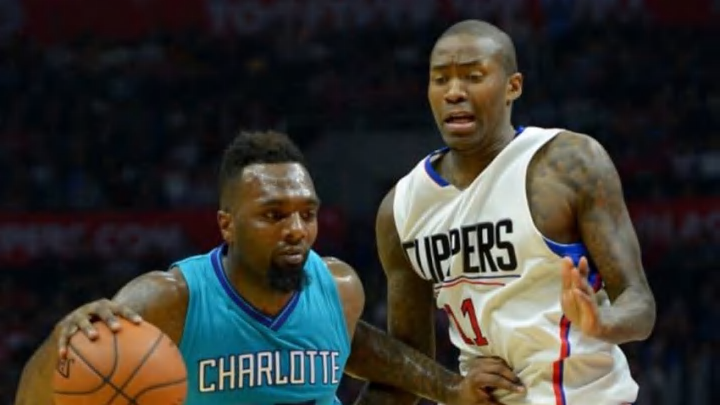Michael Kidd-Gilchrist’s early return to the starting five has created a logjam on the wing for the Charlotte Hornets. Would trading P.J. Hairston solve that problem?
The return of Michael Kidd-Gilchrist has given the Charlotte Hornets a much needed boost. They are only 2-2 since his return, but one of those victories came against the Eastern Conference-leading Cleveland Cavaliers and on Friday night, they nearly knocked off the Miami Heat. Kidd-Gilchrist brings defensive stability and a relentless energy to Charlotte’s starting lineup, which is something they had been severely lacking all season.
The only person that might not be so thrilled with the return of MKG is P.J. Hairston. Before Kidd-Gilchrist came back, Hairston started 43 games, averaging 19.9 minutes per game. In the last four games, Hairston has been bumped from the starting lineup and is averaging only 14.5 minutes per game. That includes 20 minutes of garbage time in a blowout victory over the Los Angeles Lakers. In the other three contests he played 14 minutes, 11 minutes and 13 minutes.
With Michael Kidd-Gilchrist back, the Hornets just don’t really need Hairston. Kidd-Gilchrist does everything Hornets coach Steve Clifford has asked Hairston to do and MKG does it better. Clifford elected to start Hairston for most of the season over more offensively polished players like Jeremy Lamb and Troy Daniels because he viewed Hairston as Charlotte’s best healthy perimeter defender. Even through his severe offensive struggles, Hairston continued to start thanks to that perceived defensive value.
Through 47 games this season, Hairston has struggled to find any consistency on offense. He’s currently averaging only 6.1 points and 2.7 rebounds per game on 35.9 percent shooting and a 7.58 PER. In college at the University of North Carolina and during his time in the D-League, he was regarded as a knockdown three-point shooter. That hasn’t proven to be true through his first two seasons in the NBA.
Last season he struggled to find playing time because of that poor shooting. He played in only 45 games and shot a disappointing 30.1 percent from outside. But, that’s understandable. Being a rookie in the NBA is difficult. Perhaps 2015-16 would be different.
Hairston’s minutes increased, but it was more of the same from three-point range. Hairston heads into Saturday night’s meeting with the Washington Wizards having improved his three-point shooting percentage to only 31.4 percent. That’s only a 1.3 percent bump from his disastrous rookie season. It’s hard to call someone a shooter when they don’t make shots.
Now, I know what you’re thinking. Why does that matter if Steve Clifford thinks he’s some kind of defensive stud? In reality, the only defensive value he provides is due to his size. He’s not actually an above average defensive player; it’s all an illusion. Especially when you take a look at the advanced statistics.
More from Charlotte Hornets
- Brandon Miller, not Victor Wembanyama, is the rookie to watch in 2023
- 5 players who will challenge Victor Wembanyama for Rookie of the Year
- Ranking the 10 championship-less NBA teams by closeness to title
- 4 Reasons drafting Scoot Henderson should be a no-brainer for Hornets
- Ranking the 5 best available power forwards in 2023 NBA free agency
With Hairston on the court this season, the Hornets allow 110 points per 100 possessions, without him they allow 101.6. Hairston’s real defensive plus/minus is also a putrid -1.45, placing him as the 68th ranked small forward in the league. Shouldn’t good defensive players have a positive impact on your overall team defense? Now that Kidd-Gilchrist is back Clifford can stop pretending like Hairston is some sort of defensive prodigy in the making.
At this point of his career, he’s just not a very good NBA player. The Hornets are pushing for a playoff spot so they don’t have time to let him develop and attempt to figure things out with his shot. When Al Jefferson returns, they’ll have a completely healthy roster for the first time all season, which means it will be time to tighten up the rotation and consistently play their best lineups. That would likely leave Hairston as the odd man out on many occasions.
The question remains, now that you have no use for Hairston, what do you do with him? The obvious answer is to trade him. If he’s not going to play significant minutes for the Hornets they should make him available and see what they can get for him. It won’t be much, maybe only a second round pick. But trading Hairston gives Steve Clifford a clearer view of what his rotation looks like. Sometimes having too many players vying for playing time is a problem.
More hoops habit: NBA Trade Rumors: 5 Landing Spots For Greg Monroe
This way Hairston won’t steal minutes from more impactful players like Jeremy Lamb, Jeremy Lin, Michael Kidd-Gilchrist and even Troy Daniels. Hairston may one day turn into a reliable NBA player. It just doesn’t look like it will happen in Charlotte.
